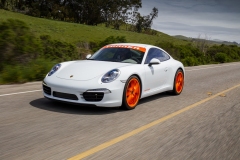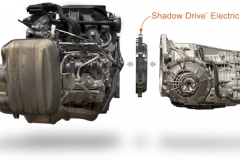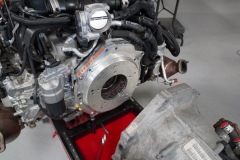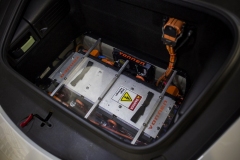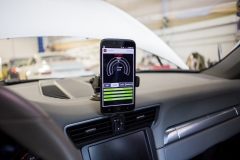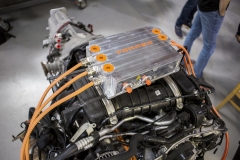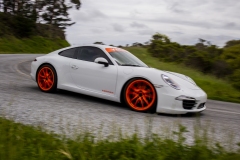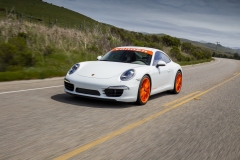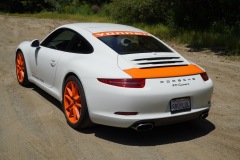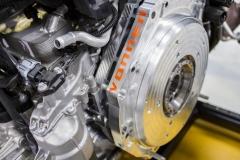Powerful Inline Electric Hybrid System Adds HP To Our Favorite Sports Car
Since the first automobile, enthusiasts have always clamored for ways to hot-rod their cars to go faster. Over the years, carburetors, camshafts, turbochargers, superchargers, nitrous-oxide injection and exotic fuels have been the way to satisfy that go-fast itch.
With the current move to electrification of vehicle powertrains, hybrid battery-electric systems have become the newest method of gaining an edge. In racing, hybridization is now becoming the must-have technology to win.
Realizing the advantages of hybrid powertrains, Vonnen, based in the heart of Silicon Valley, has developed an innovative aftermarket, bolt-on hybrid system that takes a regular Porsche 911 and adds an electric motor between the engine and transmission, along with a battery and control unit.
The Vonnen Shadow Drive (VSD)

The VSD electric motor is a thin-profile unit, about the thickness of a pizza box, that is sandwiched between the 911’s gasoline engine and the transmission, and replaces the stock flywheel and starter. The motor is tucked in the transmission’s bell housing, adding only about an inch to the powertrain’s length. With the hybridized powertrain installed, it’s impossible to see any changes to it looking into the engine bay from above or below. Despite its small size, the VSD motor adds 150 horsepower (hp) and 150 pound-feet (lb.-ft.) of torque to the 911’s powerplant.
Because the VSD is before the transmission, it benefits from the same torque multiplication that the engine does. It works with both manual and PDK transmissions, and both all-wheel and rear-wheel drive Porsches. VSD cannot power the car on its own, it’s purely an assist system, the mildest of all hybrid types, but it is still a wolf in sheep’s clothing. Unlike Turbos or superchargers, PSD generates no parasitic loss; its power is entirely self-contained, and its energy comes altogether from recaptured waste energy.

The VSD is powered by a specially designed and built 1-kilowatt-hour Li-ion battery that sits at the bottom of the 911’s frunk and only takes up a few inches, so there is room for some luggage. The battery consists of six modules that are of unique chemistry for fast discharge and recharge. Its characteristics translate into having the speed of an ultracapacitor and the storage capacity of a battery. This design means that the battery can dump its entire capacity in less than a half a minute, and recharge by regeneration again almost as fast. Because the battery design is very resilient, it can do it over and over all day long.
The battery system and the VSD motor generate a lot of heat, so each has an independent coolant loop with additional radiators that sit in front of the stock 911 engine radiators.

Controlling everything is the Vonnen Control Unit (VCU), a combination of a DC-to-AC inverter and a microcontroller. This part of the system is ingenious because it pulls vehicle data like throttle position, vehicle speed and other data from the 911’s CAN-Bus. It uses this data to calculate how much power the electric motor should produce, and when and how much regenerative energy to charge the battery during coasting or braking. But this is a one-way data transfer. Adding a VSD requires no reprogramming of the 911’s engine control unit, and the VSD is entirely invisible to it. The modified 911 is still 100 percent compliant with state and federal emission regulations.
A VSD adds 210 pounds to a 911, but, by removing the dual-mass flywheel, starter and adding a smaller 12V battery, the total weight gain is only 170 pounds or the weight of a typical passenger.
The handling characteristics of a VSD-equipped 911 is more balanced, too, because of the placement of the battery-inverter in the frunk.

A smartphone app controls the VSD and is pretty easy to use. There are three buttons, Stealth, Sport and Overboost (think of Overboost as a Ludicrous Mode). There is even a fourth mode called Off. I never actually used this mode, but it could be thought of as a valet mode. Vonnen VSD software is updated through the smartphone app.
How Does It Drive?
To find out, Vonnen threw me the keys of its demo 911, a 2013 PDK-equipped base 911, and said enjoy yourself! This 911 is one that I am familiar with, having driven an almost identical one through Germany and Europe a few years ago. It’s a reasonably fast car, with 350 hp, 287 lb.-ft. of torque and a 0-60 in about 5.0 seconds, but it gets a little winded at over 130 mph on the Autobahn. I was keen on experiencing how this VSD-equipped 911 differed from stock.

The first two modes, Stealth and Sport, are what most drivers will use most of the time. They both add 150 hp and 100 lb.-ft. to the base 911’s 350 hp/287 lb.-ft., but they differ in their application.
Stealth is your daily-driver mode, with the power applied in the low- to mid-range, which adds just enough power for around town and that extra kick to show Teslas who is still the boss.

Sport is my favorite because it applies more substantial power to the mid and upper ranges. This mode is for twisty roads and perfect for a Northern California backroad like Skyline Blvd. The VSD-equipped 911 also had a Porsche Sports Exhaust (PSE) with muffler bypass baffles on it that open when your right foot goes to the floor. This setup, combined with the electric motor and inverter whine, made for a loud, unmatched, perfect symphony. Of course, fuel economy is unchanged from the stock 911 and is dependent on the driver’s foot. The midrange power is entirely different from stock with an instant rush. Most times, the engine/VSD and PDK transmission were utterly smooth and unobtrusive, except when you got into it, and then the transmission shifts went from invisible to forceful, quick and deliberate.
Lastly is Overboost mode, which puts the VSD at full power. Horsepower stays at 150, but torque gets boosted up to 150 lb.-ft. zero-to-60 times drop from the stock 911’s 5.0 seconds to about 3.6 seconds. In Overboost, the exhaust is screaming with that distinctive sound that racing Porsches make and the electric motor and inverter whine sounds like killer bees behind you and, all the while, your eyeballs are crammed into the back of your skull. Like a fine wine, Overboost is something that is a treat, savored for special occasions. Overboost is suitable for about three or four runs before the VSD system dials back its power until its thermal management system cools itself down, which happened quite quickly.
The Bottom Line
The one significant consideration for the Vonnen VSD is the price, and it is a big one. Currently, the Vonnen Shadow Drive costs about $75,000 installed in your 991-series Porsche 911 (2012-2019) or 981-series Cayman or Boxster. Write Vonnen a check and in a few weeks, you get back a faster, cooler hybridized Porsche that is faster than any Porsche that your buddies have. The VSD is compatible with the entire 991 and 981 series, including the Carrera, Targa, Turbo and GT3. The exciting thing about the VSD is that you can move it from one compatible Carrera, Boxster or Cayman to another because it is a non-destructive installation mod.

The current version of VSD is not for everyone, given it costs as much as some Porsches do today. Still, Vonnen is in development to support older generation Boxsters, Caymans and 996/997 Porsches. They are even working on a VSD for air-cooled 911s.
Beyond Porsche, Vonnen is looking at offering a VSD for other marques, too, but that is all they would reveal. Vonnen expects that with an expanded application catalog and cost reduction efficiencies for the VSD components, future versions of VSD will be more affordable. With Vonnen’s Silicon Valley ethos of constant innovation and ruthless cost reduction, it is only a matter of time before a VSD will be within reach of mere mortals like myself.
What impressed me the most is that with automobiles becoming more and more digital and emission systems becoming more complicated, the choices for vehicle performance mods have become much more limited. The beauty of the Vonnen Shadow Drive hybrid system design is that it will work with those systems without modifying them. Automobile electrification is inevitable, but for those who still love our internal combustion engines, adding a bit of electric charge to our rides is as good as it gets.
Related Stories You Might Enjoy–More Electrified Porsche News
News: Electric Porsche Hits the Road
News: Taycan Is the Name of the First Electric Porsche

